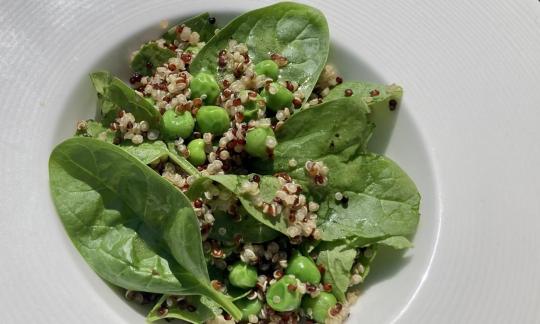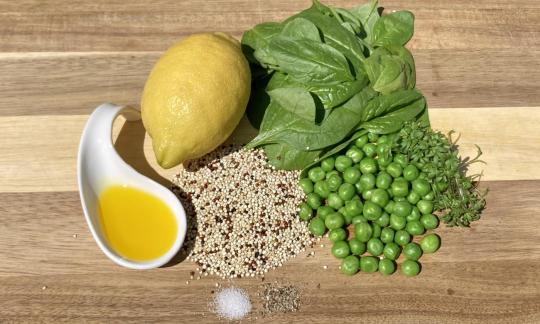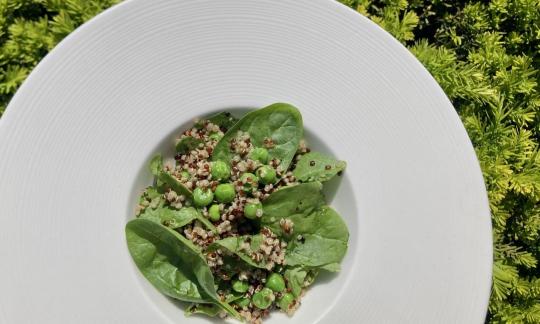Warm quinoa salad with spinach and peas
vegan
Ingredients (for servings, )
| For the quinoa | |
|---|---|
| 4 ½ oz | Quinoa, raw, peeled (organic?) |
| 4 ½ oz | Drinking water, raw (organic?) |
| For the salad | |
| 5 ½ oz | Peas, green, frozen, untreated (organic?) |
| 2 ¾ oz | Baby spinach |
| For the salad dressing | |
| 2 tbsp | Lemon juice (raw?, organic?) (0.51 oz) |
| 2 tsp | Rapeseed oil (canola, HOLL oil, kernel oil), cold pressed?, organic? (0.32 oz) |
| 1 dash | Table salt (table salt, raw?, organic?) (0.01 oz) |
| 1 dash | Black pepper (organic?, raw?) (0.00 oz) |
Equipment
- stove
- citrus juicer (lemon squeezer)
- saucepan
- sieve
- salad spinner
Type of preparation
- cook
- squeeze
- meld
- season to taste
- rinse with cold water
- drain
- Quellen lassen (ausquellen)
Preparation
For the quinoa
Wash the quinoa and drain. Then put it in a pot, add twice the amount of water and bring to the boil. Put the lid on, remove from the heat and leave to swell for about 15 minutes. The water should be completely absorbed - otherwise pour off any excess water.In the meantime, proceed with the next steps.
For the salad
Put the peas in a pan with very little water and cook over a medium heat for about 2 minutes. Then pour into a sieve, rinse with cold water and allow to drain. Wash the baby spinach and spin dry.For the dressing
For the dressing, squeeze lemon juice and mix with cold-pressed rapeseed oil and a little salt and pepper.Finishing the salad
Mix the quinoa (from step 1) with the peas, baby spinach and dressing and season with salt and pepper. Serve lukewarm.
|
Nutritional Information per person
Convert per 100g
|
2000 kcal | |
|---|---|---|
| Energy | 171 kcal | 8.6% |
| Fat/Lipids | 4.4 g | 6.3% |
| Saturated Fats | 0.43 g | 2.1% |
| Carbohydrates (inc.dietary fiber) | 26 g | 9.8% |
| Sugars | 2.2 g | 2.4% |
| Fiber | 4.4 g | 17.8% |
| Protein/Albumin | 7.1 g | 14.2% |
| Cooking Salt (Na:100.6 mg) | 256 mg | 10.6% |
| Essential micronutrients with the highest proportions | per person | 2000 kcal | |
|---|---|---|---|
| Vit | Vitamin K | 110 µg | 146.0% |
| Vit | Folate, as the active form of folic acid (née vitamin B9 and | 118 µg | 59.0% |
| Min | Manganese, Mn | 0.95 mg | 48.0% |
| Prot | Tryptophan (Trp, W) | 0.07 g | 30.0% |
| Elem | Phosphorus, P | 186 mg | 27.0% |
| Min | Copper, Cu | 0.26 mg | 26.0% |
| Prot | Threonine (Thr, T) | 0.23 g | 25.0% |
| Elem | Magnesium, Mg | 88 mg | 24.0% |
| Vit | Thiamine (vitamin B1) | 0.23 mg | 21.0% |
| Prot | Isoleucine (Ile, I) | 0.26 g | 21.0% |
Detailed Nutritional Information per Person for this Recipe
The majority of the nutritional information comes from the USDA (US Department of Agriculture). This means that the information for natural products is often incomplete or only given within broader categories, whereas in most cases products made from these have more complete information displayed.
If we take flaxseed, for example, the important essential amino acid ALA (omega-3) is only included in an overarching category whereas for flaxseed oil ALA is listed specifically. In time, we will be able to change this, but it will require a lot of work. An “i” appears behind ingredients that have been adjusted and an explanation appears when you hover over this symbol.
For Erb Muesli, the original calculations resulted in 48 % of the daily requirement of ALA — but with the correction, we see that the muesli actually covers >100 % of the necessary recommendation for the omega-3 fatty acid ALA. Our goal is to eventually be able to compare the nutritional value of our recipes with those that are used in conventional western lifestyles.
| Essential fatty acids | per person | 2000 kcal |
|---|---|---|
| Alpha-Linolenic acid; ALA; 18:3 omega-3 | 0.33 g | 16.0% |
| Linoleic acid; LA; 18:2 omega-6 | 1.4 g | 14.0% |
| Essential amino acids | per person | 2000 kcal |
|---|---|---|
| Tryptophan (Trp, W) | 0.07 g | 30.0% |
| Threonine (Thr, T) | 0.23 g | 25.0% |
| Isoleucine (Ile, I) | 0.26 g | 21.0% |
| Lysine (Lys, K) | 0.40 g | 21.0% |
| Phenylalanine (Phe, F) | 0.29 g | 19.0% |
| Valine (Val, V) | 0.31 g | 19.0% |
| Leucine (Leu, L) | 0.43 g | 18.0% |
| Methionine (Met, M) | 0.14 g | 15.0% |
| Vitamins | per person | 2000 kcal |
|---|---|---|
| Vitamin K | 110 µg | 146.0% |
| Folate, as the active form of folic acid (née vitamin B9 and | 118 µg | 59.0% |
| Thiamine (vitamin B1) | 0.23 mg | 21.0% |
| Vitamin A, as RAE | 149 µg | 19.0% |
| Vitamin C (ascorbic acid) | 14 mg | 18.0% |
| Vitamin B6 (pyridoxine) | 0.23 mg | 16.0% |
| Riboflavin (vitamin B2) | 0.18 mg | 13.0% |
| Vitamin E, as a-TEs | 1.6 mg | 13.0% |
| Niacin (née vitamin B3) | 1.3 mg | 8.0% |
| Pantothenic acid (vitamin B5) | 0.48 mg | 8.0% |
| Biotin (ex vitamin B7, H) | 2.5 µg | 5.0% |
| Essential macroelements (macronutrients) | per person | 2000 kcal |
|---|---|---|
| Phosphorus, P | 186 mg | 27.0% |
| Magnesium, Mg | 88 mg | 24.0% |
| Potassium, K | 353 mg | 18.0% |
| Sodium, Na | 101 mg | 13.0% |
| Calcium, Ca | 45 mg | 6.0% |
| Essential trace elements (micronutrients) | per person | 2000 kcal |
|---|---|---|
| Manganese, Mn | 0.95 mg | 48.0% |
| Copper, Cu | 0.26 mg | 26.0% |
| Iron, Fe | 2.6 mg | 18.0% |
| Zinc, Zn | 1.4 mg | 14.0% |
| Selenium, Se | 3.6 µg | 7.0% |
| Fluorine, F | 22 µg | 1.0% |
| Iod, I (Jod, J) | 2.1 µg | 1.0% |
The lukewarm quinoa salad with baby aspinach and green peas is quick to prepare, healthy and filling.
Nutrient profile: According to GDA guidelines, one portion of this low-calorie dish covers more than the average daily requirement of vitamin K. Manganese and folic acid are covered by about 50%. The ratio of omega-6 to omega-3 fatty acids is 4:1, below the recommended ratio of 5:1.
Since the nutrients of baby spinach are not included in the calculation, the dish is even more nutritious. You can find more information on the topic at the following link: Vegans often eat unhealthily. Avoidable nutritional errors.
Quinoa: Quinoa is a pseudo-cereal and originally comes from the South American Andes. It is practically inedible unpeeled due to the bitter saponins that cling to the shell, which is why it is only available peeled in stores. Quinoa comes in different varieties and colors: light quinoa has a soft consistency after cooking, while red quinoa tastes a little spicier and remains grainier. Black quinoa is the variety that remains the grainiest. It is recommended to always wash quinoa well before cooking to remove any traces of bitter saponins. Quinoa is gluten-free and tops the usual types of grain in terms of protein, magnesium and iron. It also contains all essential amino acids, including lysine!
Peas: Green peas have a crunchy consistency and can be used in many different dishes. They can be eaten raw and are high in protein and carbohydrates.
Spinach: Spinach ( Spinacia oleracea), also known as vegetable spinach or garden spinach, is rich in carotenoids, vitamins (especially vitamin K) and minerals. Although spinach contains a lot of oxalic acid (oxalate), eating raw spinach in large quantities is not harmful to health. Baby spinach, as used in this recipe, also has less oxalic acid than the older leaves. In large quantities, consuming foods that are high in oxalic acid can interfere with iron therapy, e.g. in the context of iron deficiency anemia. This is because oxalic acid makes it difficult for iron to be absorbed in the intestine.
lemon juice: The lemon is rich in vitamin C and antioxidants, has an antibacterial effect and strengthens the immune system. The fruity acidity of the lemon juice gives your dish a pleasant freshness. Vitamin C also improves the absorption of the iron contained in quinoa.
Cress: You can complement the salad by adding a bowl of cress.








